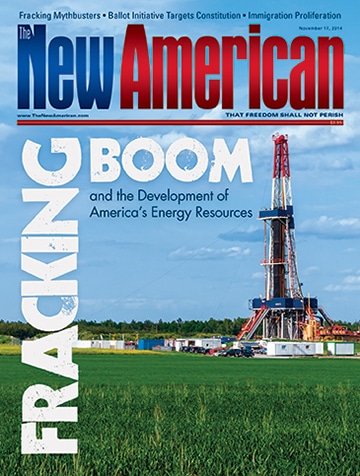Fracking Mythbusters
Myths become reality only when they are left unchallenged. There are so many myths, half-truths, misstatements, and distortions about the issue of fracking that one scarcely knows where to begin. The most egregious is the falsehood that “you can light your tap water on fire because of fracking.”
This canard first saw the light of day in Gasland, a propaganda piece produced by Josh Fox and funded and supported by various extremist members and groups affiliated with the environmental movement. Early in the film, Fox showed a flaming faucet belonging to Weld County, Colorado, homeowner Mike Markham. In that segment, when a lighted match touched water flowing from his kitchen faucet, it virtually exploded into flame.
Not mentioned in that sequence, however, was that Markham knew about his flaming faucet well before Fox showed up on his doorstep with his cameramen and that he also knew that it had nothing to do with any development of oil or natural gas near his property. Fox failed to mention that Markham had earlier asked representatives from Colorado’s Oil and Gas Conservation Commission (COGCC) to come out and survey his water. Fox also failed to include results from the COGCC upon completion of their analysis, as quoted by the commission:
We concluded that Mike Markham’s wells contained biogenic gas that was not related to oil and gas activity.
Unfortunately, Gasland dismisses our Markham finding out of hand....
It should be noted that the COGCC’s director, Dave Neslin, offered to speak with Gasland’s producer, Josh Fox, on camera during the filming of the movie.
Unfortunately, Mr. Fox declined.
It turns out that the biogenic gas — methane — was derived from natural sources. When Markham’s water well was originally drilled, it penetrated several coal beds that had released the methane into his well. It also turns out that Markham’s experience is far from unique. Burning Springs, Kentucky, and Burning Springs, West Virginia, have springs that can be set on fire thanks to natural gas that has percolated into them. The oldest burning springs, however, exist near Canandaigua, New York, with a history going back to the 1600s.
It should be noted that methane itself is not considered dangerous enough even to rate a drinking water standard.
The next myth is the claim that fracking endangers people’s health: It allegedly pollutes the air and the water, and causes breast cancer. The air pollution myth was successfully exposed by Pennsylvania’s Department of Environmental Protection when it monitored numerous fracking sites across the state and found that nearby levels of carbon monoxide, nitrogen dioxide, sulfur dioxide, and several other key pollutants didn’t exceed federal air-quality standards. Said the department, “When looking at the individual operations, the emissions do not seem to create ambient air pollution conditions where acute adverse health impacts are expected.”
This was confirmed by the Commission on Environmental Quality in Texas, which conducted an extensive study on fracking in the Barnett Shale. Researchers found “no immediate health concerns from air quality” and concluded that “oil and gas operations do not cause harmful excess air emissions.”
Likewise, West Virginia’s Department of Environmental Protection found in its studies that fracking doesn’t endanger air quality. Another study conducted in Fort Worth, Texas, concluded that “the measured and estimated air pollution levels did not reach levels that have been observed to cause adverse health effects.”
As far as aquifers being polluted by fracking fluids, this claim largely defies logic, as well as being rejected by Lisa Jackson, head of the EPA. Fracking fluids, which are 99 percent water, are injected under pressure miles below aquifers, which generally reside near the planet’s surface. To suggest that somehow those fracking fluids would migrate upwards defies both the law of gravity and capillary action as those fluids reside thousands of feet below those aquifers. It also defies Jackson. She is notoriously opposed to the use of fossil fuels, yet she testified before Congress that there have been no “proven cases where the fracking process itself has affected water.” This was confirmed by the U.S. Groundwater Protection Council, a group of public water regulators in various states, which stated that they had not seen a single instance of contamination of water by fracturing fluid.
Currently EPA officials are closely watching Pavillion, Wyoming, a tiny and remote town of 160 where high levels of chemicals linked to fracking have been found in groundwater supplies. As Popular Mechanics noted:
Pavillion’s aquifer sits several hundred feet above the gas cache, far closer than aquifers atop other gas fields.
If the investigation documents the first case of fracking fluid seeping into groundwater directly from gas wells, drillers may be forced to abandon shallow deposits.
When Josh Fox promoted the lie that fracking resulted in increases in breast cancer in his film The Sky Is Pink, it was quickly exposed by Simon Craddick Lee, a professor of medical anthropology at the University of Texas Southwestern Medical Center in Dallas, who looked at the statistics and didn’t see any spike in breast cancer rates among women living above the Barnett Shale. David Risser, an epidemiologist with the Texas cancer registry, said he found no evidence of such an increase either, nor did Dallas’ Susan G. Komen cancer advocacy group.
Next is the charge that fracking requires excessive amounts of water, which would draw down local supplies and aquifers unacceptably. This claim rests on a matter of perception: How much is too much? Fracking does require a lot of water, but compared to what? The amount of water needed to drill a single well is equal to the amount used by an 18-hole golf course in one month, according to Chris Faulkner, CEO of Breitling Energy. Phelim McAleer, producer of Frack Nation, a rebuttal to and exposé of Fox’s Gasland, viewed the matter from a slightly different perspective:
Even fracking fans have a hard time swallowing the water stats for fracked wells: the EPA estimates that fracking used between 70 and 140 billion gallons of water in 2011.
That sounds like a lot of H2O, unless you have a lawn.
Americans use 20 times more water on their lawns than they do on fracking.
A study by Carnegie Mellon University noted that the amount of water required to drill all 2,916 of the fracking wells in the Marcellus Shale in the first 11 months of 2010 would equal the amount of drinking water used by just one city, Pittsburgh, during the same period. In addition, said one of the study’s authors, the amount of water being used in fracking is roughly equivalent to the water used by other industries, such as steel manufacturing, that the state has lost.
The next charge levied by anti-frackers is that the chemicals required in the fracking process are deliberately being kept secret by the drilling companies. The implication is that, if those chemicals were published, some of them would be revealed as having links to causing cancer. In response to that calumny, an online chemical disclosure registry, FracFocus.org, has been set up, and at present publishes all the chemicals used in more than 80,000 wells across the country. Its search engine is so robust that not only can one see all of the chemicals used in the process but why each one is being utilized. It also allows users the option to search for wells nearby to see a list of chemicals being used in them.
As Breitling Energy’s CEO Faulkner explained:
Many of the chemicals are present in far greater concentrations under your sink in common household cleaners. A common chemical is also used in lipstick and contact lens solution (sorbic acid) or in plastic containers (polypropylene).
One of the chemicals most often used in the highest concentration is hydrochloric acid, naturally occurring as stomach acid.
Faulkner noted that while many drilling companies use as many as 25 different chemicals, his company only uses 16. This transparency has revealed some oddly benign ingredients, such as instant coffee and ground up walnut shells.
Faulkner went on to say that there are economic considerations involved as well:
Fracking fluid is over 99.9% water and sand. Fracking fluid serves to act as a proppant (i.e., it props open channels into the shale) so that gas can flow into the well bore and to the surface.
Chemicals are necessary to keep the process going. But chemicals are more expensive than water or sand, providing an incentive to use as little as possible.
It also should be noted that during a photo op, Colorado’s Democratic Governor, John Hickenlooper, drank fracking fluid on television to prove its safety to his local supporters.
Another charge levied by anti-frackers is borderline silly: The wastewater being retrieved from a completed well is radioactive. This was dutifully nullified by tests that were conducted on Pennsylvania waterways that had received treated water from fracking wells, which found no evidence of elevated radiation levels. Conrad Dan Volz, the former scientific director of the Center for Healthy Environments and Communities at the University of Pittsburgh, said that radioactivity in wastewater is a non-issue: “If I were to bet on this, I’d bet that it’s not going to be a problem.”
A half-truth promoted by environmentalists opposed to fracking is that fracking causes earthquakes. Earthquake tremors are measured on the Richter scale, and the only two earthquakes globally proven to have been caused by fracking of shale were recorded in Lancashire, England. They registered 1.5 and 2.4 on the Richter scale. As Faulkner noted,
Quakes under 3 are classified as imperceptible and the British Geological Survey is unable to distinguish between quakes of less than 2 and passing traffic....
As the Richter scale is exponential, most people are not aware that the difference in the energy released between a 2.4 quake and a damaging earthquake is a factor of several million.
As pointed out by William Leith, a seismologist with the U.S. Geological Survey, “Fracking itself probably does not put enough energy into the ground to trigger an earthquake. They’re not a safety hazard. That’s really not something that we should be concerned about.”
Another myth that needs to be exploded is that promoted by three anti-fracking researchers at Cornell University. They claimed that methane, leaking out during the fracking process, has much greater global-warming potential than that of carbon dioxide. This leakage, they claim, entirely offsets whatever reductions in carbon dioxide emissions would be achieved by switching from coal to gas to generate electricity. This study, happily, has been poorly received by their peers, as evidenced by a quote from their own colleagues at Cornell:
The data clearly shows that substituting natural gas for coal will have a substantial greenhouse benefit under almost any set of reasonable assumptions. Methane emissions must be five times larger than they currently appear to be before gas substitution for coal becomes detrimental from a global warming perspective on any timescale....
Here we reiterate and substantiate our charges that none of these conclusions [in the study] are warranted, especially in the light of new data and models.
There are numerous other myths, misstatements, half-truths, and canards parading as legitimate in the war against fracking. But it’s helpful to keep perspective. Hydraulic fracturing — fracking — has been successfully used for more than 60 years in this country (later refined by George Mitchell), capturing and sending to the surface more than seven billion barrels of oil and 600 trillion cubic feet of natural gas. If any of these charges and claims had merit, they certainly would have surfaced before now.
Photo: AP Images


